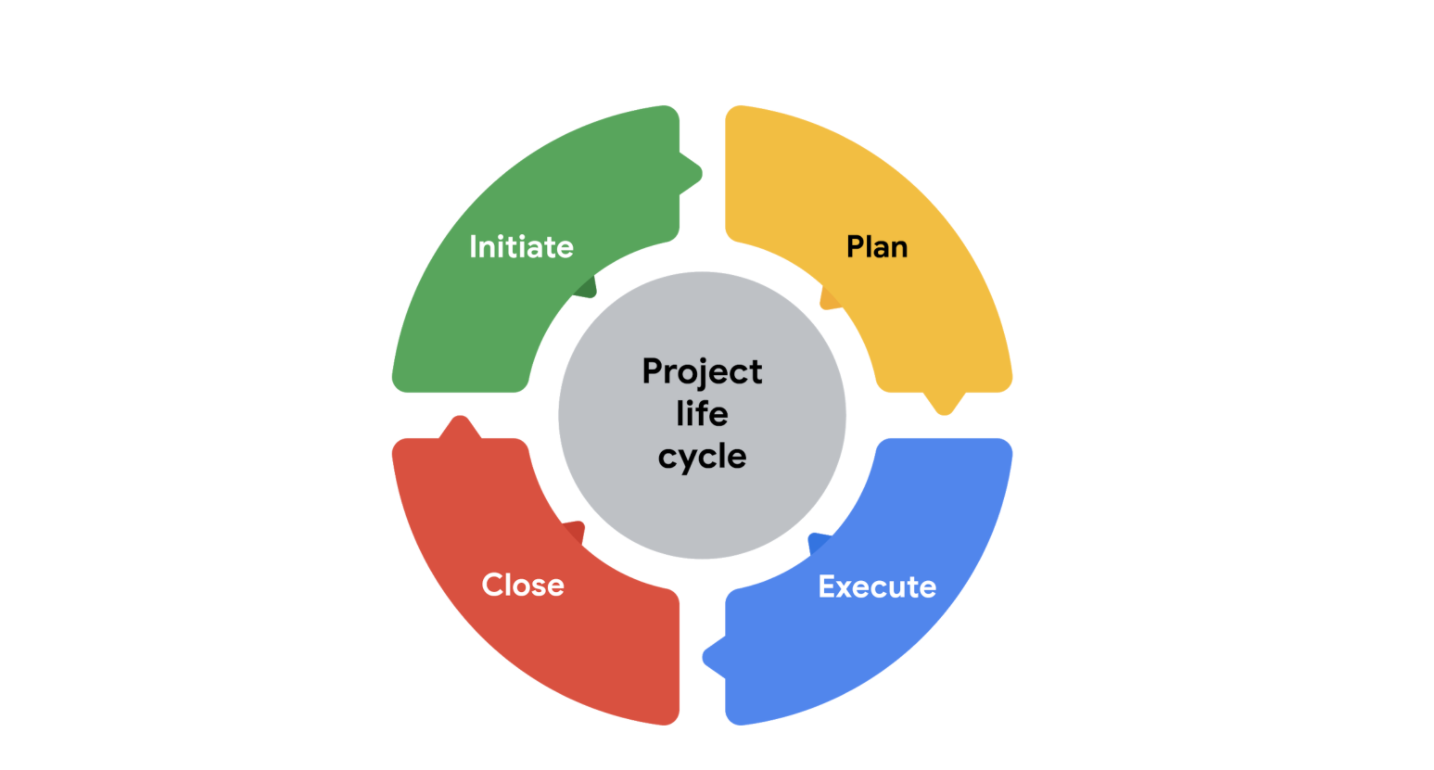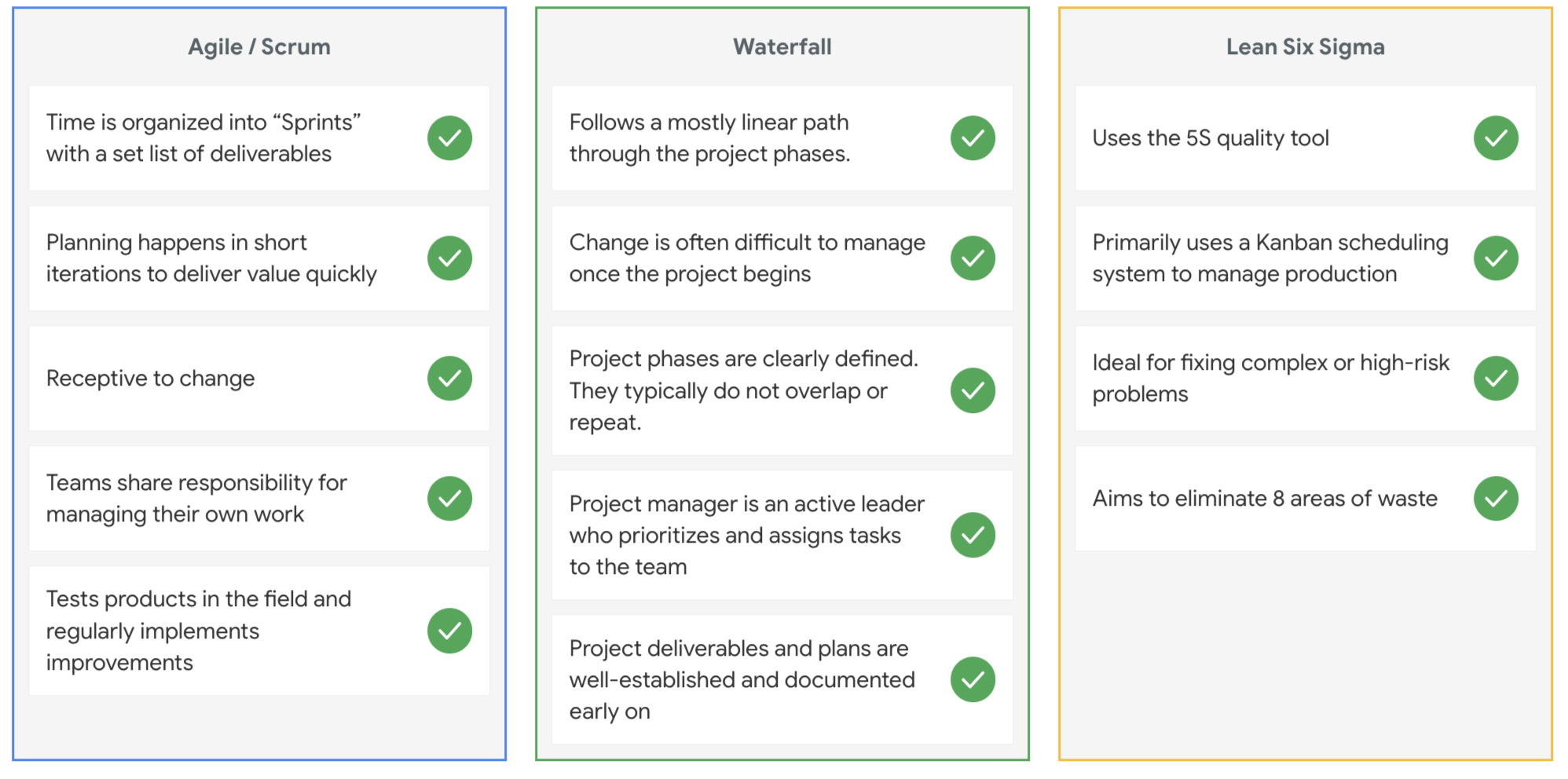Week3 - Project life cycle and methodologies

Life cycle
Initiate a project
- Who are the stakeholders?
- What are the client's or customer's goals?
- What is the purpose and mission of the project?
- What are the measurable objectives for the team?
- What is the project trying to improve?
- When does this project need to be completed?
- What skills and resources will the project require?
- What will the project cost? What are the benefits?
Make a plan
In this phase, make a plan to get your project from start to finish.
Create a detailed project plan. What are the major milestones? What tasks or deliverables make up each milestone?
Build out the schedule so you can properly manage the resources, budget, materials, and timeline. Here, you will create an itemized budget.
- Create a budget
- Set the schedule
- Establish your team
- Determind roles and responsibilities
- Plan for risk and change
Executing and completing tasks
- Manage the progress
- Communicate
- Make adjustments
Monitor your project team as they complete project tasks.
Break down any barriers that would slow or stop the team from completing tasks.
Help keep the team aware of schedule and deliverable expectations.
Address weaknesses in your process or examine places where your team may need additional training to meet the project's goals.
Adapt to changes in the project as they arise.
Closing a project
- Ensure all tasks are completed
- Confirm acceptance of the project outcome
- Reflect on lessons learned (retrospective)
- Communicate results with stakholders
- Celebrate completion
- Formaly move from the project
Methodologies
Waterfall and Agile
| Agile | Waterfall | |
|---|---|---|
| Project manager's role | Project manager serves as an active leader by prioritizing and assigning tasks to team members. | Agile project manager (or Scrum Master) acts primarily as a facilitator, removing any barriers the team faces. Team shares more responsibility in managing their own work. |
| Scope | Project deliverables and plans are well-established and documented in the early stages of initiating and planning. Changes go through a formal change request process. | Planning happens in shorter iterations and focuses on delivering value quickly. Subsequent iterations are adjusted in response to feedback or unforeseen issues. |
| Schedule | Follows a mostly linear path through the initiating, planning, executing, and closing phases of the project. | Time is organized into phases called Sprints. Each Sprint has a defined duration, with a set list of deliverables planned at the start of the Sprint. |
| Cost | Costs are kept under control by careful estimation up front and close monitoring throughout the life cycle of the project. | Costs and schedule could change with each iteration. |
| Quality | Project manager makes plans and clearly defines criteria to measure quality at the beginning of the project. | Team solicits ongoing stakeholder input and user feedback by testing products in the field and regularly implementing improvements. |
| Communication | Project manager continually communicates progress toward milestones and other key indicators to stakeholders, ensuring that the project is on track to meet the customer's expectations. | Team is customer-focused, with consistent communication between users and the project team. |
| Stakeholders | Project manager continually manages and monitors stakeholder engagement to ensure the project is on track. | Team frequently provides deliverables to stakeholders throughout the project. Progress toward milestones is dependent upon stakeholder feedback. |
Lean and Six Sigma
DMAIC Define, measure, analyze, improve, and control
Lean
Lean methodology is often referred to as Lean Manufacturing because it originated in the manufacturing world. The main principle in Lean methodology is the removal of waste within an operation. By optimizing process steps and eliminating waste, only value is added at each phase of production.
Lean Manufacturing methodology recognizes eight types of waste within an operation: defects, excess processing, overproduction, waiting, inventory, transportation, motion, and non-utilized talent. In the manufacturing industry, these types of waste are often attributed to issues such as:
- Lack of proper documentation
- Lack of process standards
- Not understanding the customers' needs
- Lack of effective communication
- Lack of process control
- Inefficient process design
- Failures of management
- These same issues create waste in project management.
Implement Lean project management when you want to use limited resources, reduce waste, and streamline processes to gain maximum benefits.
You can achieve this by using the pillars of the Lean 5S quality tool. The term 5S refers to the five pillars that are required for good housekeeping: sort, set in order, shine, standardize, and sustain. Implementing the 5S method means cleaning up and organizing the workplace to achieve the smallest amount of wasted time and material. The 5S method includes these five steps:
- Sort: Remove all items not needed for current production operations and leave only the bare essentials.
- Set in order: Arrange needed items so that they are easy to use. Label items so that anyone can find them or put them away.
- Shine: Keep everything in the correct place. Clean your workspace every day.
- Standardize: Perform the process in the same way every time.
- Sustain: Make a habit of maintaining correct procedures and instill this discipline in your team.
Within the Lean methodology, 5S helps you boost performance.
The final concept of Lean uses a Kanban scheduling system to manage production. The Kanban scheduling system, or Kanban board, is a visualization tool that enables you to optimize the flow of your team's work. It gives the team a visual display to identify what needs to be done and when. The Kanban board uses cards that are moved from left to right to show progress and help your team coordinate the work.
Kanban boards and 5S are core methods of the Lean methodology. They can help you successfully manage your project. Now let's analyze the Six Sigma method and learn when is the best time to use it.
Six Sigma
Six Sigma is a methodology used to reduce variations by ensuring that quality processes are followed every time. The term "Six Sigma" originates from statistics and generally means that items or processes should have 99.9996% quality.
The seven key principles of Six Sigma are:
- Always focus on the customer.
- Identify and understand how the work gets done. Understand how work really happens.
- Make your processes flow smoothly.
- Reduce waste and concentrate on value.
- Stop defects by removing variation.
- Involve and collaborate with your team.
- Approach improvement activity in a systematic way.
Use this methodology to find aspects of the product or process that are measurable like time, cost, or quantity. Then inspect that measurable item and reject any products that do not meet the Six Sigma standard. Any process that created unacceptable products has to be improved upon.
Now that you understand both Lean and Six Sigma, let's see how they come together to improve the performance of your project!
Lean Six Sigma
After both Lean and Six Sigma were put into practice, it was discovered that the two methodologies could be combined to increase benefits. The tools used in Lean, such as Kanban boards and 5S, build quality in processes from the beginning. Products developed using Lean methods are then inspected or tested using Six Sigma standards. The products that do not meet these standards are rejected.
The largest difference between these methodologies is that Lean streamlines processes while Six Sigma reduces variation in products by building in quality from the beginning and inspecting products to ensure quality standards are met. You may find that one of these two methods—or using them both together—can improve the efficiency of your projects.
Popular project management approaches
Which project management methodologies should you use?
All approaches can be combined with others, depending on the needs of your project.
Waterfall is a traditional methodology in which tasks and phases are completed in a linear, sequential manner, and each stage of the project must be completed before the next begins. The project manager is responsible for prioritizing and assigning tasks to team members. In Waterfall, the criteria used to measure quality is clearly defined at the beginning of the project.
Agile involves short phases of collaborative, iterative work with frequent testing and regularly-implemented improvements. Some phases and tasks happen at the same time as others. In Agile projects, teams share responsibility for managing their own work. Scrum and Kanban are examples of Agile frameworks, which are specific development approaches based on the Agile philosophy.
Scrum is an Agile framework that focuses on developing, delivering, and sustaining complex projects and products through collaboration, accountability, and an iterative process. Work is completed by small, cross-functional teams led by a Scrum Master and is divided into short Sprints with a set list of deliverables.
Kanban is a tool used in both Agile and Lean approaches that provides visual feedback about the status of the work in progress through the use of Kanban boards or charts. With Kanban, project managers use sticky notes or note cards on a physical or digital Kanban board to represent the team's tasks with categories like "To do," "In progress," and "Done."
Lean uses the 5S quality tool to eliminate eight areas of waste, save money, improve quality, and streamline processes. Lean's principles state that you can do more with less by addressing dysfunctions that create waste. Lean implements a Kanban scheduling system to manage production.
Six Sigma involves reducing variations by ensuring that quality processes are followed every time. The Six Sigma method follows a process-improvement approach called DMAIC, which stands for define, measure, analyze, improve, and control.
Lean Six Sigma is a combination of Lean and Six Sigma approaches. It is often used in projects that aim to save money, improve quality, and move through processes quickly. Lean Six Sigma is also ideal for solving complex or high-risk problems. The 5S organization framework, the DMAIC process, and the use of Kanban boards are all components of this approach.
